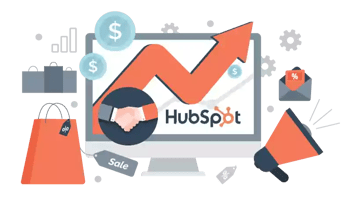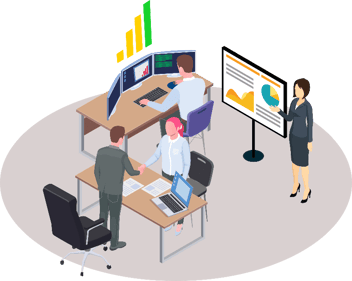What Are Sales Playbooks, and How Do I Set Them Up?
If your top-performing salesperson were to leave your company tomorrow, would your entire sales process walk out the door with them? Would you lose the invisible map that guides you to your biggest deals? Is your sales strategy repeatable?
This isn't a hypothetical question—it's a direct challenge to the scalability of your business. If you find yourself struggling to consistently generate revenue and onboard new reps, you likely have a process problem, not a personnel problem. The solution? A Sales Playbook.
A modern Sales Playbook is not a dusty binder of outdated scripts but the definitive, digital, and dynamic blueprint for generating repeatable revenue. It turns scattered, anecdotal knowledge into a standardized, winning approach that every single member of your team can follow.
The concept has deep roots in structured environments, such as sports, where every player knows the "play" for every scenario on the field. Today, top-tier sales teams have adopted this same approach to formalize and standardize the process of winning deals. The goal is simple: to make your team's collective success predictable.
This guide will take you beyond the definition and into the practical, data-driven steps of implementing an effective Sales Playbook to create a scalable, high-performing sales organization.
The Data-Driven Case for Playbooks: Why They Aren't Optional Anymore
The belief that a great sales enablement process is simply "tribal knowledge" shared only among top performers is outdated and, more importantly, is actively holding back your revenue. When we look at the numbers, the decision to implement a Sales Playbook is a clear-cut business case. It's time to stop relying on instinct and start utilizing structure.
The Direct Revenue and Performance Impact
The financial impact of standardized processes is significant and undeniable:
-
Higher Revenue Growth: Companies that use a structured sales process, which is formalized within a Sales Playbook, see 28% higher revenue growth than organizations that do not. Ask yourself: are you leaving nearly a third of your potential revenue on the table simply by lacking documentation?
-
High Performance Rates: Sales teams that follow a well-defined, documented sales process are 33% more likely to be classified as High Performers, with those companies reporting win rates that frequently exceed 50%. This isn't a coincidence; it's a direct result of process clarity leading to execution efficiency.
-
Increased Deal Size: Structure doesn't just help you close more deals; it helps you close bigger deals. Aberdeen research suggests that companies using a Sales Playbook can see an increase of up to 3.9% in their average deal size. A well-guided sales motion naturally leads to better qualification and more strategic cross-selling and upselling opportunities.
Accelerating Time-to-Quota and Stabilizing Your Team
The benefits extend beyond closed deals to the efficiency and stability of your workforce. Onboarding a new Sales Development Rep (SDR) can be a lengthy, expensive process. Playbooks drastically cut down on that cost:
-
Faster Onboarding and Ramp-Up: Sales Playbooks act as a ready-made training program, cutting new rep ramp-up time by a reported 30-50%. For a new hire with a typical 6-month ramp-up time, a high-quality playbook can save up to three months of low productivity. Imagine the capital efficiency when your new team members become revenue producers that much faster.
-
Increased Quota Attainment: When enablement programs focus on playbook adoption, the results are powerful. A significant study revealed that the average sales representative quota attainment increased by 31% among the participating cohort. This demonstrates the clear link between accessible guidance and individual performance, effectively helping B-players perform more like A-players.
-
Reducing Sales Team Turnover: By providing clear expectations and the tools for success, playbooks reduce the anxiety and confusion that often lead to sales rep frustration and eventual turnover. A confident, enabled rep is a retained rep.
Despite this overwhelming evidence, an estimated 40% of sales teams still do not use a formal sales playbook. Ignoring the data means accepting slower growth and unpredictable revenue. Moving from tribal knowledge to a formal playbook is the single greatest act of risk mitigation a sales leader can undertake.
What Makes a Winning Playbook? Essential Components & Structure
To be effective, a Sales Playbook must be a central, easy-to-use hub. It contains two main parts: the foundational strategy and the scenario-based plays. This resource is not just for closing; it applies to every marketing, prospecting, and sales environment across your organization.
Foundational Strategy: The "Who" and "Why"
This section anchors your team's efforts, ensuring a uniform understanding of the market and the customers:
-
Ideal Customer Profile (ICP) and Buyer Personas: This is more than a job title. It includes detailed profiles on customer pain points, the roles within the buying committee, and the specific motivations for change. You should include a "Questions to Ask" cheat sheet for each persona to drive better discovery calls and quickly disqualify leads that don't fit your profile.
-
Competitive Battlecards: These are quick, digestible overviews of your top competitors. Each card should list their weaknesses, your key differentiators, and mandatory questions reps must ask prospects to uncover a competitive advantage. This prevents reps from being caught off guard when a competing solution is mentioned.
-
Company Messaging and Value Proposition: Codify the approved language for describing your offering. This ensures every rep speaks with a single, consistent voice and maintains brand integrity across all touchpoints, from a cold email to a final pitch deck.
The Core "Plays": Repeatable Actions for Repeatable Results
The "plays" are the heart of the Sales Playbook—specific, repeatable actions that address a single scenario.
A play is a specific set of steps and accompanying assets designed for a single goal, such as handling a specific objection, following up after a product demonstration, or re-engaging a cold lead.
Every effective play should include four elements:
-
Trigger: The event that tells the rep when to use the play (e.g., "Prospect says, 'Your price is too high.'").
-
Goal: The desired outcome (e.g., "Schedule a follow-up meeting to review the ROI breakdown.").
-
Steps: The specific actions to take (e.g., "Use the 'Price vs. Value' script," "Send the ROI calculator content asset").
-
Assets: The content, templates, or talk tracks required to complete the steps.
Today's most powerful Sales Playbooks are becoming highly sophisticated. The trend is shifting toward dynamic playbooks—guides that adapt in real-time based on live deal data.
For example, Gartner predicts that 75% of B2B sales organizations will augment traditional sales playbooks with AI-powered guided selling solutions by 2025.
This means plays are getting more innovative, more integrated, and far more accurate, moving from mere documentation to active, intelligent guidance.
From Concept to Conversion: Implementing and Digitizing Your Playbook
A brilliant playbook document is useless if it's trapped in a shared folder that no one opens. Implementation requires a careful approach combining process, platform, and coaching.
Step 1: The Process First Approach
Building the right playbook requires gathering the institutional knowledge that already works:
-
Codify and Collaborate: Do not build the playbook in a vacuum. The most valuable plays are not theoretical; they are the specific, stable processes and winning talk tracks used by your top performers. Interview your A-players, record their calls, and transcribe their closing sequences. This ensures the playbook reflects reality, not just wishful thinking.
-
Prioritize Plays: You don't need a play for everything on day one. Focus on high-impact scenarios: the top three objections, the two most common competitor challenges, and the process for qualifying your highest-value lead type.
-
Iterate and Validate: Treat the playbook like a living, breathing document. Roll out initial plays in small pilot groups, track their success, and gather feedback on their usability. An excellent example of a high-value process to codify is a clear "Go/No-Go" checklist that qualifies a lead based on firm criteria, such as BANT (Budget, Authority, Need, Timeframe) or MEDDIC (Metrics, Economic Buyer, Decision Criteria, Decision Process, Identify Pain, Champion). This ensures that unqualified leads are dropped early, freeing up valuable rep time to focus on opportunities that can actually be closed.
Step 2: Selecting the Right Platform and CRM Integration
The modern Sales Playbook must live inside the CRM. This is the only way to provide just-in-time guidance to the rep based on the deal stage or prospect profile.
Platforms like HubSpot allow you to transform a static guide into dynamic, contextual content. By leveraging the Playbooks feature within HubSpot's Sales Hub, you can embed coaching prompts, discovery questions, and competitive messaging that appear within the rep's workflow. This means when a rep moves a deal to the "Demonstration Scheduled" stage, the playbook instantly provides the best-practice discovery questions and success criteria for that meeting.
The advantage of a digital platform is immediate consistency and accessibility. It eliminates the need for reps to search or toggle between systems, which vastly improves adoption and usage, and ensures every rep is always using the latest, most effective version of the content.
Step 3: Monitoring, Coaching, and Continuous Improvement
A Sales Playbook is not an endpoint; it is the starting point for effective sales coaching and a feedback loop for your entire sales enablement strategy.
-
Coaching Accountability: Managers should use playbook adherence as a key performance indicator (KPI). A coaching session shouldn't focus on what a rep did wrong in a subjective sense, but rather on which specific play they failed to follow or execute effectively. This provides a solid foundation for targeted skills development.
-
Key Performance Indicators (KPIs): Tracking the proper metrics proves the playbook's value. Beyond the revenue metrics already mentioned, focus on:
-
Adoption Rate: How often are reps accessing the playbooks?
-
Play Effectiveness: What is the conversion rate when a specific play is used versus when it is not?
-
Deal Velocity: Are deals moving faster through the stages where playbooks are implemented?
-
-
The Feedback Loop: Successful sales teams constantly refine their playbooks. When a rep discovers a new, effective objection-handling technique, that insight must be immediately captured, verified, and integrated into the living playbook to benefit the entire organization.
Strategic Use Cases: When Do You Deploy a Playbook?
Plays are designed for scenarios that are either high-frequency, high-value, or high-friction. Having a structured approach in these moments maximizes the chance of a positive outcome.
Here are a few high-impact Sales Playbooks examples:
-
The Competitor Battlecard Play: A play that automatically triggers when a specific competitor's name is mentioned in a call or email. It instantly surfaces approved talking points, key differentiators, and a recommended strategy for steering the conversation away from the competitor's strength and toward your unique value.
-
The Specific Objection Handling Play: Dedicated to tackling the most common objections (e.g., pricing, feature parity, timing). This play provides a three-step resolution script (Acknowledge, Isolate, Overcome), relevant case study links, and a clear path to get the deal back on track, transforming what used to be a point of friction into a moment of confidence.
-
The Follow-Up Play for Stalled Deals: An automated sequence of communication (email templates, internal tasks for the manager, etc.) designed to re-engage any deal that has been sitting in a pipeline stage for a defined period (e.g., more than 14 days) to prevent it from quietly dying. This ensures no opportunity is lost due to neglect or forgetfulness.
-
The Discovery Call Play: This play provides a mandated sequence of qualifying questions aligned with your ICP, ensuring every rep extracts the necessary information to move the deal forward or disqualify it quickly, preventing wasted time on poor-fit opportunities.
Turning Strategy into Scalable Revenue
A Sales Playbook is the single most effective tool for building a high-growth, high-retention sales team. It transforms your institutional knowledge into institutional revenue. By injecting stability into your core processes, you reduce risk, onboard faster, and equip every rep with the collective wisdom of your best performers.
If you are ready to stop relying on individual genius and implement a data-driven Sales Playbook—and integrate it seamlessly within your HubSpot environment—connect with our team of Sales Enablement experts at Aspiration Marketing. We specialize in codifying your winning strategies to build a reliable, repeatable revenue engine.
This content is also available in:
- German: Was sind Sales Playbooks und wie richte ich sie ein?
- Spanish: ¿Qué son las guías de ventas y cómo configurarlas?
- French: Que sont les Sales Playbooks et comment les mettre en place ?
- Italian: Cosa sono i Sales Playbook e come si impostano?
- Romanian: Ce sunt manualele de vânzări și cum le configurez?
- Chinese: 什么是销售手册,如何设置?

Joachim is a certified HubSpot trainer with over 13 years of experience in content marketing, strategy, website development, and SEO. He has implemented numerous large-scale, international growth marketing programs, including one with UiPath, which grew from a startup to a successful IPO on the NYSE. Joachim has special expertise in multilingual marketing and sales enablement projects, and he uses the latest AI technologies to help our clients.









Leave a Comment